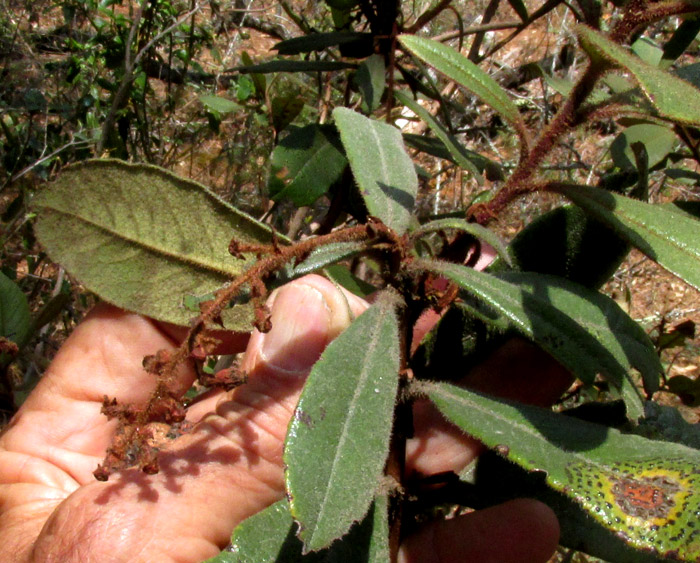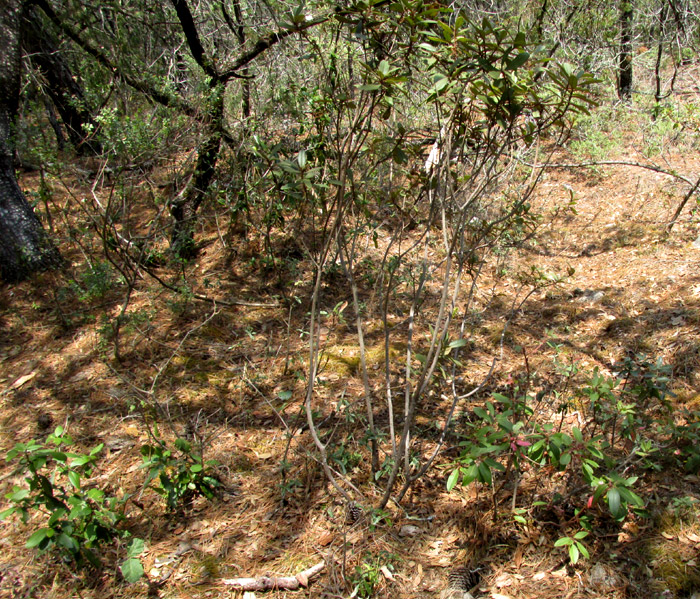Excerpts from Jim Conrad's
Naturalist Newsletter
Entry from field notes dated May 7, 2023, atop hill forested with pines and oaks about 1km east of Curva de la Doctorcilla, on unnamed road connecting Hwy120 and El Doctor; limestone bedrock; elevation ±2650m (8700 ft); Eastern Sierra Madre mountains of east-central Querétaro state, MÉXICO, (N20.88°, W99.62°)
ARBUTUS XALAPENSIS, GLANDULAR VARIANT

The above branch grew on a lanky, sprawling, woody shrub about 2.5m tall (8ft), atop a hill on which pines in the oak-pine forest were dying or already dead because of pine beetles. The bush occupied a cluttered spot where sunlight and wind broke through the ever more fractured canopy. In relation to the pine disaster, it seemed to be part of the forest's healing process.
With regard to the shrub's identity, already I'd learned that this kind of plant does something interesting in our region; here was a new installment in my ongoing learning process. The previous day, along the gravel road in the valley just below the hill, I'd encountered a shrub much like this one, except that it was flowering, not bearing old fruits like this one, plus its hairiness and leaf color were different, as shown on our Arbutus mollis page. This was yet another variation on the Arbutus theme. Up north Arbutus species are known as madrones, or arbutuses.
In the above picture, note that leaf undersurfaces are paler than the upper surfaces, but they're not nearly as strikingly silvery-white as seen on Arbutus mollis, also found in this area. Also, Arbutus mollis produces much longer hairs which aren't as rusty colored as these. You might enjoy seeing more variations on the Arbutus theme on our pages for Arbutus tessellata and Pacific Madrone.

The above black fruit, when ripe, should be red or orangish. Possibly it dried up before maturing properly, for this was the end of a very long, severe dry season after a rainy season that never developed properly. Still, the fruit's grainy, or tuberculate, surface texture can be seen, as well as the persistent style atop the fruit, all consistent with this being an arbutus, of the Heath or Azalea Family, the Ericaceae.

Our arbutus's hairs were tipped with glands, best seen above at the picture's top, left. Vegetative parts are densely hairy, but leaf undersurfaces are not so hairy that the green leaf surface below the hairs can't be seen. And here's what the sprawling bush itself looked like in its habitat:

Despite arbutuses being well-known trees and bushes, their taxonomy isn't settled, and it's not even clear how the genus is to be defined. Moreover, often the species tend to hybridize with one another.
In the 2014 Flora del Bajío treatment of Arbutus species in this part of upland central Mexico, five of Mexico's seven species are documented as occurring in our area, and those species display several variations and instances of hybridization. In the Flora it's stated that this region's arbutus species exhibit an extraordinary diversity of forms, and their taxonomy is still confusing -- "... una extraordinaria diversidad de formas cuya taxonomía es aún confusa."
According to the Flora, if in our area you have an Arbutus with leaves densely covered with gland-tipped hairs averaging around 1.5mm long, and the leaf undersurfaces are paler than the upper surfaces but NOT strikingly so and NOT so dense and entangled that the blade's green surface can't be seen below the hairs, you have the "glandular variant" of ARBUTUS XALAPENSIS.
In the US, Arbutus xalapensis is called Texas Madrone, but the species is distributed from Texas throughout the uplands of Mexico and Central America so, here in its main homeland, that name won't do. The xalapensis part of the name honors the town of Xalapa, Veracruz, Mexico, on some maps spelled Jalapa.
Our "glandular variant" of Arbutus xalapensis once was elevated to species level under the name Arbutus glandulosa, but nowadays the consensus is that our bushes don't comprise a distinct species, rather just a local variation of the more widely distributed and very variable Arbutus xalapensis. The Flora describes two formally recognized varieties of Arbutus xalapensis (not mere variations), but I'm unsure which our plant would be.
In the US, Arbutus xalapensis is thought of as a bush or tree up to 25m tall (84ft), and developing red, smooth and heavily flaking bark like several other madrone species. This smaller, bushy variant doesn't do that. Our variant has a low profile, and is described as providing forage for livestock and browsing for wildlife. On tree-type forms, wildlife and people eat the fruits, but it's unclear if people seek our hairy, glandular variant for any reason.
Learning about all the Arbutus variations and hybrid forms in this small area, one visualizes arbutuses in general as still vigorously experimenting with how to be an arbutus in a rapidly changing world. I think climate change and recent decades of ever-more-severe droughts weakened the forest atop this hill. The pines' lost much of their resistance to the beetle onslaught, and the pines' diminishing presence is leaving holes in the forest fabric. Our glandular variation of Arbutus xalapensis, just by being itself, is healing the forest as well as it can.
Some may say the bush is only good for forage and browsing, but there's a higher calling our bush is responding to.
Entry dated April 20, 2024, from notes taken about 1.5km northeast of Puerto de los Velazquez, Municipality of Pinal de Amoles; N21.138°, W99.665°, elevation ~2780 meters (~9120 feet); oak/pine/fir borderline cloud-forest on limestone bedrock; in the Eastern Sierra Madre Mountains of east-central Querétaro state, MÉXICO
ARBUTUS XALAPENSIS, NON-GLANDULAR VARIANT

Atop a windy ridge, the above tree branch, out of reach but accessible with a small telephoto lens, had lost most of last season's leaves, but new leaves were emerging from terminal buds. Last season's inflorescences remained, each now bearing a few developing fruits, as seen below.


In the above picture's lower, left, in the background, new leaves emerge from a terminal bud. Branch stems entering from the left are smooth, reddish, and in places beginning to peel into papery flakes. At the right, an enlargement of the above picture shows two immature fruits still green, but already displaying bumpy surfaces. The fruits' thick pedicels are densely covered with very short, velvety hairs.

Stems, buds and petioles of last season's leaves bore no hint of long, glandular hairs.

Bark on the tree's forked trunk was flaky, and the picture indicates that the tree was several meters tall.
This individual was much different from the variant documented atop this page. Keep in mind remarks of the Flora del Bajío that this region's arbutus species exhibit an extraordinary diversity of forms, and their taxonomy is still confusing; they display "... una extraordinaria diversidad de formas cuya taxonomía es aún confusa."